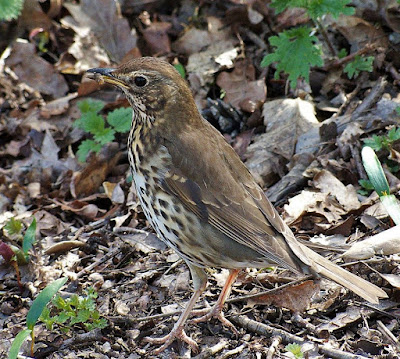 |
| Song Thrush in woodland - Photo by Mark Appleton |
Now is a great time of year to listen to the Dawn chorus, with International Dawn Day just having occurred on Sunday May 4th. If you can get up before there is any light in the sky, it really is worth hearing the Dawn Chorus build up to a crescendo. Not everyone can get to a green space or has a garden so I will try and bring a little bit of nature to you
I was outside on a couple of occasions at 4.45 am last week, a good hour before sun rise. On these two occasions one of the first birds to start the dawn chorus was the Song thrush. Therefore I have decided to write a blog on the Song Thrush with comparisons to the Mistle Thrush. The Song Thrush is less common than the blackbird but is still a very common bird found in many gardens. The Mistle Thrush is the scarcest of our three garden thrushes. It has a preference for larger gardens with tall, mature trees.
 |
| Song Thrush perched on a garden bush - Photo by Tony Tiller |
There are six regularly occurring 'British' larger thrushes. These are Blackbird, Ring Ouzel, Song Thrush, Mistle Thrush, Redwing and Fieldfare. Redwing and Fieldfare are termed winter thrushes and the Ring Ouzel is usually a passage migrant.
All feed on a variety of insects, invertebrates and fruit. Blackbirds are woodland and parkland birds. feeding in leaf litter or on lawns and they eat plenty of worms, insect larvae but also plenty of fruit. Song Thrushes on the other hand are shyer birds with a greater preference for the cover of woodland and a higher proportion of invertebrates in their diet. They particularly favour snails and you may find shells in your garden where the snails have been bashed on stones which have been used as an anvil.
People do sometimes confuse the Song Thrush with the Mistle Thrush and can be hard to identify in photographs.
Song Thrush
It has dark spots that are neat, dark arrow shapes that point upwards towards its head and usually arranged in neat rows. The breast also has a slight yellow/brown colour which the Mistle Thrush does not have. The contrasting pale belly should also rule out the female Blackbird, In flight the Song Thrush has pale yellow/brown on its underwing closest to its body.
 |
| Song Thrush running - Photo by Paul Willis |
 |
| Song Thrush looking for food - Photo by Mark Appleton |
Key Features of Song Thrush are:-
- Warm brown on top with a speckled underside
- Speckles are upward pointed arrow shapes arranged in neatish lines
- Plain looking face
- Yellow/brown infusion on upper breast
Mistle Thrush
 |
| Mistle Thrush - Photo by Mark Appleton |
 |
| Mistle Thrush looking for food - Photo by Mark Appleton |
The Mistle Thrush is larger than a Song Trush with longer wings and tail.
Sometimes it is useful to identify the bird in its surroundings as well as by its actual appearance. A Mistle thrush often feeds in fruit trees which is a big help for identification. Also has a long thick bill. The jumbled arrangement and shape of breast spots, not being as arrow shaped as in a Song Thrush is also a good clue. In flight the underwing is white unlike that of the Song Thrush.
Key Features of Mistle Thrush are:-
- Typical speckled thrush appearance
- Spots are 'blob-like' and scattered, rather than in neat rows
- Upper parts have a lighter or colder tone
- It has a large, strong bill
One feature that is unmistakeable in identification between the Song Thrush and Mistle Thrush is its song. Song thrushes have a most distinctive song which is very loud. It has a similar tone of a blackbird but each short phrase is repeated two, three or four times before a slight pause, then the repetition of a new phrase. As mentioned at the start of this blog, it can be heard very early at the beginning of the day when there is little light in the sky, but also at the end of the day rather than during the middle of the day. For a Song Thrush song, click on the following link:- Song Thrush
The Mistle Thrush songs are similar to Blackbird, but more stereotyped and simple in structure and rhythm. Has been described as a sadder sound than the Blackbirds. Again sings most frequently at dawn and dusk, usually singing from the tops of tall trees. For a Mistle Thrush song, click on the following link:- Mistle Thrush Song
For further information on the Song Thrush and Mistle Thrush click on the following links:-
RSPB - Song Thrush
Garden Birds - Song Thrush
WoodlandTrust - Song Thrush
RSPB - Mistle Thrush
Garden Birds - Mistle Thrush
WoodlandTrust - Mistle Thrush
and lastly
A BIG SHOUT OUT FOR ALL OUR ESSENTIAL KEY WORKERS WHO ARE DOING AN AMAZING JOB IN THESE DIFFICULT TIMES
No comments:
Post a Comment